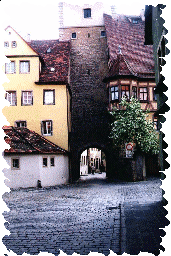
Old Buildings and Ancient Tower
| Rothenburg |
| The Little City that Time Forgot |
Some distance to the north is the historic town of Rothenburg overlooking the Tauber river. A one-time economic power, it fell into decline and was overlooked by progress. Ironically, this has resulted in the preservation of the place in near-original medival condition.
 Old Buildings and Ancient Tower |
During its heyday, Rothenburg grew larger than its defensive walls had originally allowed for, so nowadays the small city consists of several districts, each separated with the remnants of huge walls. And in many places, the walls were taken down altogether, replaced with more functional buildings. Here two establishments cosy up against the old White Tower, which -- unlike the defensive bulwarks that used to stand beside it -- retained some usefulness. |
| Just outside the west gate of the city one finds the beautiful gardens. While not defended by the city's heavy walls, the garden is actually protected by natural cliffs that drop precipitously to the valley below. |
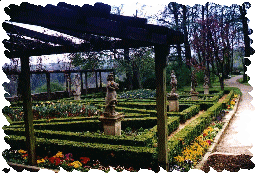 City Gardens |
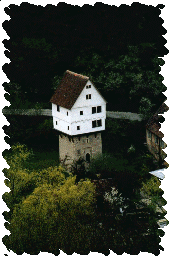 Precarious Perch |
In this case, the expression "A Man's House is his Castle" was never more true. Looking down from the garden into the valley one sees this peculiar structure: Toppler Castle, built for a 14th Century mayor as a summer residence. During the "bad old days," a defensible position was an utter necessity, as illustrated here. But if you outgrow the place, why abandon it? Just add an upstairs floor ... or two ... or four. |
| At the northern end of the great semicircular arc of extended wall surrounding Rothenburg (the other half being defended by cliffs) is found the Klingentor (Klingen Gate.) Built in the 14th Century, in the 16th Century it took on the added responsibility of holding some of the city's water with a copper resevoir installed within it. From the Klingentor, you can ascend some steps to walk atop the wall, looking out across the German countryside from restored battlements. It also affords an excellent perspective on the city itself. |
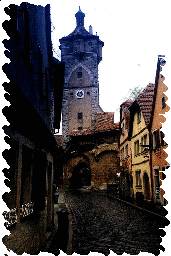 The Klingen Gate |
| A place doesn't get more medival than this. It doesn't take much to imagine the carts and mongers, the housewives buying bread each morning. The children carrying back water from the fountain. The lost itinerant merchant looking for the guild hall. The livestock roaming free in the streets. Admittedly, our sanitized view of the past does overly romanticize the time; we conveniently forget the filth and disease that pervaded city life. But compared to the present, it does suggest a less complicated time. This place, the Plönlein, shows Sieber's tower to the left, and the way down to the Kobolzeller gate to the right. |
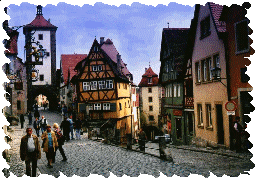 Medival Streets |
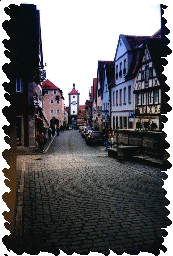 Streets Lost in Time |
Though motor vehicles are allowed in the inner city, they're only permitted during certain hours. This makes the city quite pedestrian-friendly. And also makes for a timeless effect. Here again, looking at Sieber's Tower from the other side, it's not hard to imagine what this street looked like a couple of centuries ago. |
| If you take the journey up the Rathaus (Town Council Hall) tower, you'll wind up circular stairs, cross through old storage chambers, wend through tight corridors, and finally, spiral up steep wooden steps until reaching the little tower overlooking the market square. But the view of the city, and the surrounding countryside is well worth the effort. |
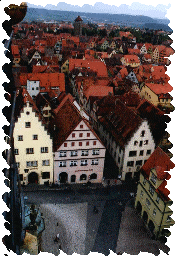 View from the Rathaus Tower |
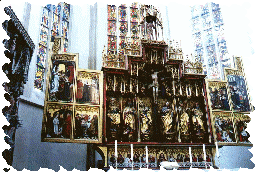 Cathederal Altar |
The old Gothic cathederal, St. Jacob's, being less ornate than the baroque Ettal, is nevertheless dramatic, with it's lofty columns and tall stained glass windows. Found within the old cathederal are two ornate altars. This one at the east end of the church, the Altar of the Twelve Apostles, dates back to the late Fifteenth century. In an upper recess is another altar, elaborately carved by a famous local wood carver, Tilman Riemenschneider. |